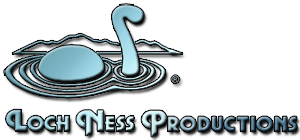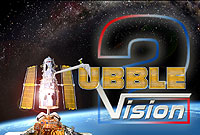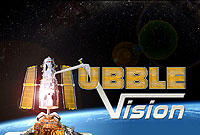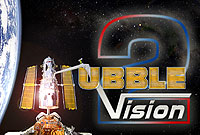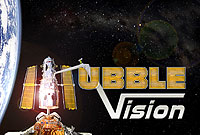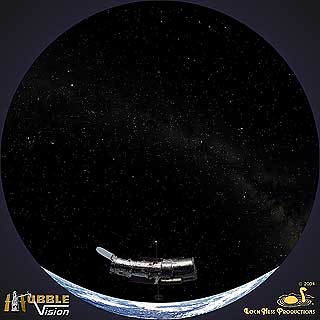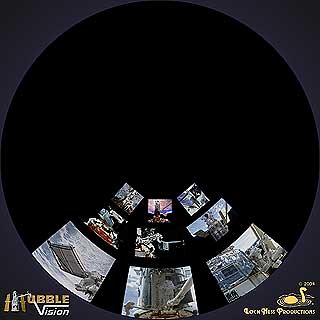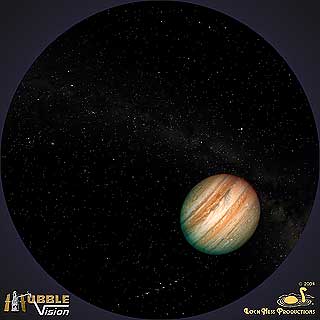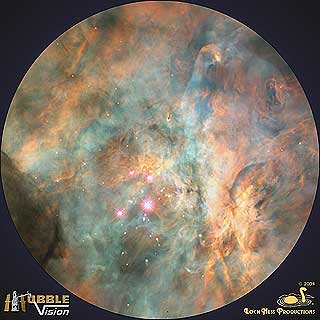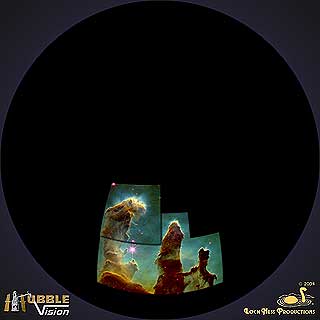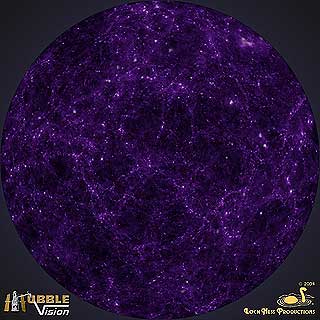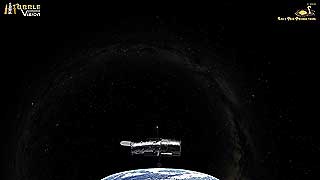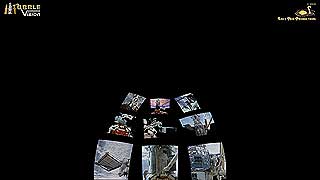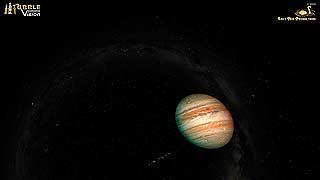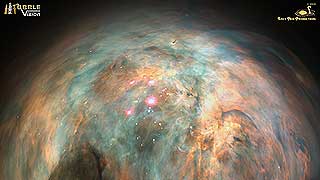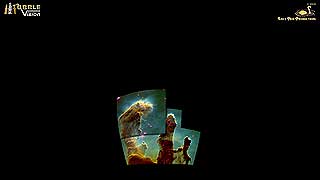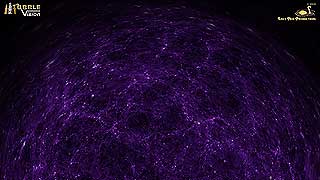HUBBLE Vision 2
A fascinating tour of the cosmos — from Earth orbit!
Since its launch in 1990, the Hubble Space Telescope has provided incredible images in unprecedented detail to astronomers, and made an astonishing array of discoveries — from nearby objects in the solar system to the most distant galaxies at limits of the observable universe.
We've taken the best and most exciting Hubble images and woven them into an engaging story of cosmic exploration, bringing the wonders of the universe to audiences everywhere. HUBBLE Vision 2 is a fascinating tour of the cosmos — from Earth orbit.
 HUBBLE Vision 2 is actually our third show about this remarkable observatory. In this all-new production, major themes in current astronomy and cosmology are presented: new views of the planets; peeks into starbirth nurseries; visions of stardeath in its many forms; explorations of star clusters and galaxies; and views of the universe when the earliest galaxies were first coming into being.
HUBBLE Vision 2 is actually our third show about this remarkable observatory. In this all-new production, major themes in current astronomy and cosmology are presented: new views of the planets; peeks into starbirth nurseries; visions of stardeath in its many forms; explorations of star clusters and galaxies; and views of the universe when the earliest galaxies were first coming into being.
 We catch glimpses of solar system objects, including the Moon and Venus; clouds on dusty Mars; Comet Shoemaker-Levy 9's crash into Jupiter; storms on Saturn, Uranus, and Neptune; and the faraway worlds of Pluto and Quaoar. Beyond the solar system, we explore protoplanetary disks in the Orion Nebula, and regions of starbirth across the cosmos. We witness the deaths of stars like our Sun; the cataclysmic aftermath of supernovae in the Crab Nebula; and the expanding rings around Supernova 1987a. We see breathtaking views of colliding galaxies; jets shooting from active galactic nuclei, powered by supermassive black holes; the eerie effects of gravitational lenses; and deep-field views of the most distant galaxies ever seen.
We catch glimpses of solar system objects, including the Moon and Venus; clouds on dusty Mars; Comet Shoemaker-Levy 9's crash into Jupiter; storms on Saturn, Uranus, and Neptune; and the faraway worlds of Pluto and Quaoar. Beyond the solar system, we explore protoplanetary disks in the Orion Nebula, and regions of starbirth across the cosmos. We witness the deaths of stars like our Sun; the cataclysmic aftermath of supernovae in the Crab Nebula; and the expanding rings around Supernova 1987a. We see breathtaking views of colliding galaxies; jets shooting from active galactic nuclei, powered by supermassive black holes; the eerie effects of gravitational lenses; and deep-field views of the most distant galaxies ever seen.
 The images in HUBBLE Vision 2 began as digital files released by the Space Telescope Science Institute, NASA, the European Southern Observatory, and by scientists working directly with HST data. Then we carefully reframed, resized, cropped and enhanced the images for optimal planetarium display. We've also created original artwork and graphics to supplement and illustrate other points of the show.
The images in HUBBLE Vision 2 began as digital files released by the Space Telescope Science Institute, NASA, the European Southern Observatory, and by scientists working directly with HST data. Then we carefully reframed, resized, cropped and enhanced the images for optimal planetarium display. We've also created original artwork and graphics to supplement and illustrate other points of the show.
 Bring the Space Telescope's exciting discoveries to audiences of all ages. HUBBLE Vision 2 is a factual journey through the universe, as seen through the unblinking eye of one of the world's premier telescopes — a planetarium show done in the professional style you expect from Loch Ness Productions.
Bring the Space Telescope's exciting discoveries to audiences of all ages. HUBBLE Vision 2 is a factual journey through the universe, as seen through the unblinking eye of one of the world's premier telescopes — a planetarium show done in the professional style you expect from Loch Ness Productions.
 Running time: 30:00
Running time: 30:00
Age level: General public
Year of production: 2004 updated 2009
Narrated by Wren Ross
Words expertly crafted by Carolyn Collins Petersen
Stereo soundtrack with original music by Geodesium
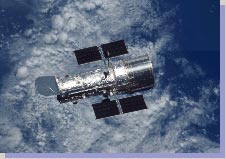 HUBBLE Vision 2
HUBBLE Vision 2
Science Education Content
The educational focus of this show is to present the discoveries made by the Hubble Space Telescope, explaining the objects it has observed and the processes that shape the cosmos. This is done via a set of multidisciplinary themes woven throughout the program. These ideas help relate the information presented in the show to the lives of students and their families. The language level is appropriate for students at the middle-school level and above, as well as the general public.
Show content is relevant in the following subject areas:
Earth and Space Sciences:- Objects in the solar system: planets (moons, surface characteristics, atmospheres, magnetic field phenomena), comets
- Extra-solar objects: stars, supernovae, nebulae, clusters, galaxies, and black holes
- How we use Hubble Space Telescope to explore the cosmos
- How objects look in different realms of the electromagnetic spectrum
- Processes of starbirth, stardeath (astrophysical processes)
- Deducing the existence of black holes by effects on host galaxies
- Determination of cosmic distances
- Exploring the structure of the universe
- Hubble Space Telescope and its science instruments
- Optical, infrared, and ultraviolet capability of the Space Telescope
- Hubble Space Telescope servicing missions
POSTER (2500 x 3300 pixels, ~3MB)
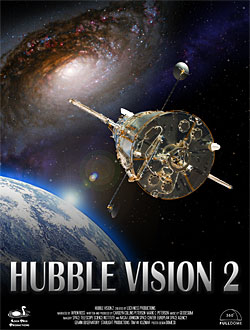
LOGOS
 In our promotional efforts, we're calling this show HUBBLE Vision 2, so it won't be confused with its 1994-1995 predecessor show. However, this probably won't matter to your audiences (unless you think they may remember that title from the last time you ran it!) So if you'd like to present this show and simply call it HUBBLE Vision (without the 2) we understand — and are happy to provide the 2-less versions of our promo art here as well. Maybe someday we'll produce a HUBBLE Vision 3 show! If you do choose a 2-less version, you'll note a nice open area where you can add the name of your planetarium, as in the example on the left.
In our promotional efforts, we're calling this show HUBBLE Vision 2, so it won't be confused with its 1994-1995 predecessor show. However, this probably won't matter to your audiences (unless you think they may remember that title from the last time you ran it!) So if you'd like to present this show and simply call it HUBBLE Vision (without the 2) we understand — and are happy to provide the 2-less versions of our promo art here as well. Maybe someday we'll produce a HUBBLE Vision 3 show! If you do choose a 2-less version, you'll note a nice open area where you can add the name of your planetarium, as in the example on the left.
FRAMES - fulldome (select for high-resolution)
FRAMES - warped (select for high-resolution)
How do you handle updates for the latest discoveries?
SHORT ANSWER: We don't. You may.
LONG ANSWER: Fortunately, as of this writing, Hubble is still operating and providing lots of new pictures and science. But while we can use Hubble to look back in time, we have nothing that allows us to look forward into the future.
It would be impractical for us to record new narration and change the entire show with every HST press release. And, we can't simply toss in newly released images into the existing package, because the show's narration naturally won't describe and explain them.
So, in pre-show welcoming remarks to the audience, we suggest that planetarians include words to the effect:
"HUBBLE Vision is an overview of the most significant images and discoveries made since the telescope was launched. It was produced in the spring of 2004. But the mission is still continuing. I'll be back after the program is over to show you some brand-new images I just downloaded from the Space Telescope Science Institute."
Then go for it!
What do you say about the end of the mission?
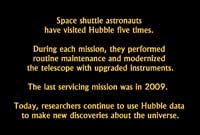
SHORT ANSWER: Nothing, in the narration; there's a generic HST Status text at the show's end.
LONG ANSWER: As of this writing, Hubble's ultimate fate has yet to be determined. While we hope it doesn't come to a premature conclusion, the situation will undoubtedly develop in ways we can't predict.
So, at the end of the show's narration, before the credits, we've provided an HST Status text display — like this one. When and if significant events warrant, we'll simply change the wording of the text. Customers should contact us to replace their show.
What's the most recent picture included with the show?
ANSWER: The Ultra Deep Field, released 9 March 2004.
Why does the narrator refer to Pluto and Charon as a double planet? What about the 2006 IAU ruling?
ANSWER: When we wrote the first script for HUBBLE Vision, the term "double planet" was just coming into vogue among astronomers. It was a sort of shorthand for the fact that Pluto and Charon interact more like two small planets together rather than a planet and its moon.
The argument for the term double planet is largely based in the characteristics and dynamics of the system. Pluto's diameter is 2,272 km, Charon is 1,212 km. That makes Charon half of Pluto's size; its mass is roughly 12-14 percent of Pluto's (the Earth-Moon system ratio is roughly 0.012). This affects their orbital interactions. When the center of mass of a double or binary system is not located under the surface of either object, then both are in orbit around that center of mass, the barycenter. This is the case in the Pluto system.
Here are some citations; each has some variation of the double planet theme in their explanations:
http://airandspace.si.edu/exhibitions/exploring-the-planets/online/pluto/pluto_atmos.html
http://www.daviddarling.info/encyclopedia/D/double_planet.html
http://hubblesite.org/newscenter/newsdesk/archive/releases/1990/14/image/a
http://www.seds.org/nineplanets/nineplanets/pluto.html
http://adsabs.harvard.edu/abs/1983ApJ...267..872T
http://adsabs.harvard.edu/abs/1999DPS....31.2903S
http://adsabs.harvard.edu/abs/1997hst..prop.3569T
http://www.nature.com/nature/journal/v439/n7072/abs/nature04351.html
Although in 2006 the IAU re-defined Pluto as a "dwarf planet", our script actually talks about something else. It says: "In 1978, Pluto was discovered to be a 'double' planet, with its companion, Charon." This is still perfectly true; in 1978, Charon's discovery did indeed alter Pluto's single status. This historical event we report is (and will remain) unchanged.
Select a link to preview the trailer.
Shows from Loch Ness Productions come with English language soundtracks standard. Translated soundtracks are provided as additional items, not substitutes for the English ones. If your show's movies contain multiplexed audio, you'll receive separate movie files for each language.
Don't see the language you want? Let's work together to create it. Read more here!
